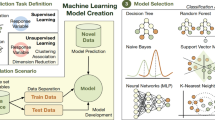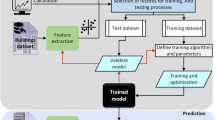Abstract
Accurate prediction of the heat load is the basic premise of intelligent regulation of the heating system, which helps to realize effective management of heating, ventilation, air conditioning system. For the problem that the weight of each influencing factor is not taken into account in the current heat load prediction and is not highly targeted, this article deeply explores the influence of different factors on the room heat load, and we propose a method to calculate room heat load prediction based on the combination of analytic hierarchy process (AHP) and back-propagation (BP) neural network. Firstly, eight environmental factors affecting the heat load are selected as prediction inputs through parametric analysis, and then the weights of each input are determined by AHP and normalize the prediction data by combining expert opinions, and finally do one-to-one training the quantified score and the room heat load to predict the future heat load by BP neural network. The simulation tests show that the mean absolute relative error (MARE) of the proposed prediction method is 5.40%. This article also verifies the influence of different expert opinions on the stability of the model. The results show that the proposed method can guarantee higher prediction accuracy and stability.
Similar content being viewed by others
Abbreviations
- A :
-
judgment matrix [−]
- a :
-
relative importance [−]
- c :
-
number of data [−]
- C.I :
-
consistency index [−]
- C.R :
-
consistency ratio [−]
- d :
-
rank difference between variables [−]
- E :
-
comprehensive score [−]
- R.I :
-
random consistency index [−]
- S :
-
quantitative values matrix [−]
- V :
-
comprehensive evaluation set [−]
- v :
-
index [−]
- W :
-
weights matrix [−]
- α :
-
number of input neurons [−]
- β :
-
number of output neurons [−]
- Δ :
-
integer between 1 and 10 [−]
- θ :
-
number of hidden layer neurons [−]
- λ :
-
eigenvalues [−]
- ρ :
-
rank correlation coefficient [−]
- i, j :
-
1, 2, …, n
- n :
-
matrix size
- max:
-
maximum
- o:
-
other expert
- f:
-
first-level indicator
- s:
-
secondary indicators
- AHP:
-
analytic hierarchy process
- BP:
-
back-propagation
- HVAC:
-
heating, ventilation and air conditioning
- KF:
-
Kalman filter
- MAE:
-
mean absolute error
- MARE:
-
mean absolute relative error
- MLPM:
-
machine learning prediction methods
- MPC:
-
model predictive control
- NNPM:
-
neural network prediction methods
- TFM:
-
traditional forecasting methods
- SVM:
-
support vector machine
References
Ahamed MS, Guo H, Tanino K (2020). Modeling heating demands in a Chinese-style solar greenhouse using the transient building energy simulation model TRNSYS. Journal of Building Engineering, 29: 101114.
Ahmad MW, Mourshed M, Yuce B, et al. (2016). Computational intelligence techniques for HVAC systems: A review. Building Simulation, 9: 359–398.
Buttitta G, Finn DP (2020). A high-temporal resolution residential building occupancy model to generate high-temporal resolution heating load profiles of occupancy-integrated archetypes. Energy and Buildings, 206: 109577.
Chang C, Zhu N, Yang K, et al. (2018). Data and analytics for heating energy consumption of residential buildings: The case of a severe cold climate region of China. Energy and Buildings, 172: 104–115.
Chang SJ, Hsu CI, Lin CT (2020). Using FAHP and CBR to evaluate the intention of adoption of Internet banking service: The example of web ATM. Journal of Intelligent & Fuzzy Systems, 39: 2869–2879.
Chellaswamy C, Ganesh Babu R, Vanathi A (2021). A framework for building energy management system with residence mounted photovoltaic. Building Simulation, 14: 1031–1046.
Choi EH, Bae SS, Jee HK (2013). Prioritization for water storage increase of agricultural reservoir using FAHP method. Journal of Korea Water Resources Association, 46: 171–182.
Chou JS, Bui DK (2014). Modeling heating and cooling loads by artificial intelligence for energy-efficient building design. Energy and Buildings, 82: 437–446.
Delcroix B, Ny JL, Bernier M, et al. (2021). Autoregressive neural networks with exogenous variables for indoor temperature prediction in buildings. Building Simulation, 14: 165–178.
Guo Q, Tian Z, Ding Y, et al. (2015). An improved office building cooling load prediction model based on multivariable linear regression. Energy and Buildings, 107: 445–455.
Guo L, Du W, Yang J, et al. (2020). A thermal load forecasting algorithm based on trajectory tracking. Mathematical Problems in Engineering, 2020: 1–12.
Khorsand R, Ghobaei-Arani M, Ramezanpour M (2018). FAHP approach for autonomic resource provisioning of multitier applications in cloud computing environments. Software: Practice and Experience, 48: 2147–2173.
Korjenic A, Bednar T (2011). Impact of lifestyle on the energy demand of a single family house. Building Simulation, 4: 89–95.
Li Q, Meng Q, Cai J, et al. (2009). Predicting hourly cooling load in the building: A comparison of support vector machine and different artificial neural networks. Energy Conversion and Management, 50: 90–96.
Li N, Wang K, Cheng J (2015). A research on a following day load simulation method based on weather forecast parameters. Energy Conversion and Management, 103: 691–704.
Liu L, Fu L, Jiang Y (2015). An on-off regulation method by predicting the valve on-time ratio in district heating system. Building Simulation, 8: 665–672.
Liu M, Sun C, Zhang B, et al. (2018). Optimized operation of an existing public building chilled station using TRNSYS. Buildings, 8: 87.
Lu T, Viljanen M (2009). Prediction of indoor temperature and relative humidity using neural network models: model comparison. Neural Computing and Applications, 18: 345–357.
Ma D Y, Sun B, Liu C (2021). Short-term cooling and heating power load prediction method based on multi-weather information. Power System Technology, 45(3): 1015–1022. (in Chinese)
Nielsen HA, Madsen H (2006). Modelling the heat consumption in district heating systems using a grey-box approach. Energy and Buildings, 38: 63–71.
Ran S, Li X, Xu W, et al. (2020). A solar-air hybrid source heat pump for space heating and domestic hot water. Solar Energy, 199: 347–359.
Roy S, Roy R, Balas VE (2018). Estimating heating load in buildings using multivariate adaptive regression splines, extreme learning machine, a hybrid model of MARS and ELM. Renewable and Sustainable Energy Reviews, 82: 4256–4268.
Salque T, Marchio D, Riederer P (2014). Neural predictive control for single-speed ground source heat pumps connected to a floor heating system for typical French dwelling. Building Services Engineering Research and Technology, 35: 182–197.
Wang M, Tian Q (2013). Application of wavelet neural network on thermal load forecasting. International Journal of Wireless and Mobile Computing, 6: 608–614.
Xu W, Liu C, Li A, et al. (2020). Feasibility and performance study on hybrid air source heat pump system for ultra-low energy building in severe cold region of China. Renewable Energy, 146: 2124–2133.
Yuan T, Zhu N, Shi Y, et al. (2018). Sample data selection method for improving the prediction accuracy of the heating energy consumption. Energy and Buildings, 158: 234–243.
Yun K, Luck R, Mago PJ, et al. (2012). Building hourly thermal load prediction using an indexed ARX model. Energy and Buildings, 54: 225–233.
Zhang Q, Tian Z, Ma Z, et al. (2020). Development of the heating load prediction model for the residential building of district heating based on model calibration. Energy, 205: 117949.
Zhang K, Kummert M (2021). Evaluating the impact of thermostat control strategies on the energy flexibility of residential buildings for space heating. Building Simulation, 14: 1439–1452.
Zhao F, Sun B, Zhang CH (2016). Cooling, heating and electrical load forecasting method for CCHP system based on multivariate phase space reconstruction and Kalman filter. Proceedings of the CSEE, 36: 399–406. (in Chinese)
Zhao J, Liu X (2018). A hybrid method of dynamic cooling and heating load forecasting for office buildings based on artificial intelligence and regression analysis. Energy and Buildings, 174: 293–308.
Zheng G, Zhu N, Tian Z, et al. (2012). Application of a trapezoidal fuzzy AHP method for work safety evaluation and early warning rating of hot and humid environments. Safety Science, 50: 228–239.
Acknowledgements
This research was supported by the Natural Science Foundation of China (No. 61765012); the Natural Science Foundation of Inner Mongolia Autonomous Region (No. 2021LHBS05005); the Science and Technology Research Project of Inner Mongolia Autonomous Region Higher Education (No. 2021SHZR0620); the Inner Mongolia Autonomous Region 2017 Science and Technology Innovation Guidance Award Funding Projects (No. 2017CXYD-2); the Natural Science Foundation of Inner Mongolia Autonomous Region (No. 2019MS05008). The funders had no role in the design of the study; in the collection, analyses, or interpretation of data; in the writing of the manuscript, or in the decision to publish the results.
Author information
Authors and Affiliations
Corresponding author
Electronic Supplementary Material
Rights and permissions
About this article
Cite this article
Tan, X., Zhu, Z., Sun, G. et al. Room thermal load prediction based on analytic hierarchy process and back-propagation neural networks. Build. Simul. 15, 1989–2002 (2022). https://doi.org/10.1007/s12273-022-0905-0
Received:
Revised:
Accepted:
Published:
Issue Date:
DOI: https://doi.org/10.1007/s12273-022-0905-0




